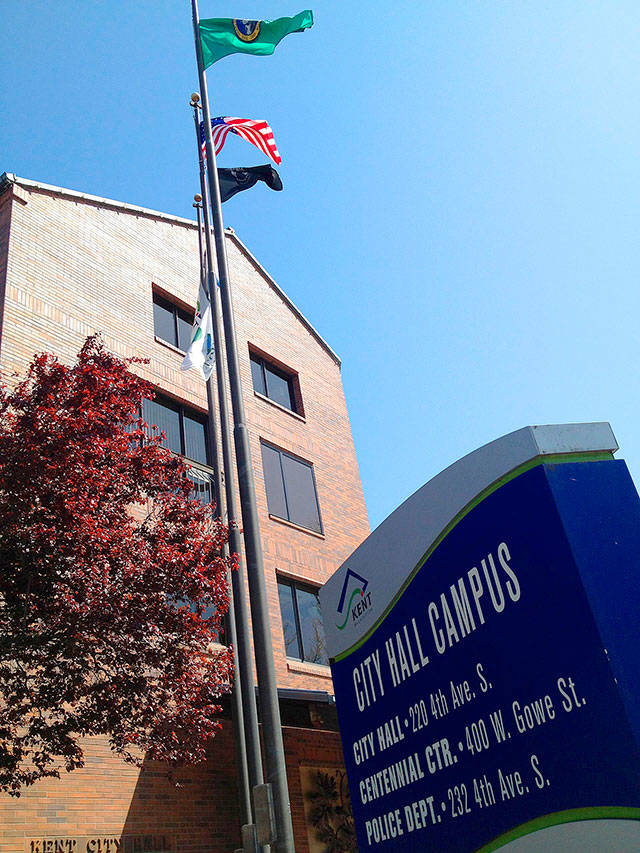Starting in 2020, the city of Kent could cut as many as 18 jobs and begin a series of increases in the city’s business and occupation (B&O) tax in a proposal to help replace lost state-shared revenue.
City leaders plan to cut expenses by $2.1 million in 2020, including about $1.1 million in Parks, Recreation and Community Services. No cuts are planned for public safety. In fact, the city plans to add three police officers per year over the next several years.
Mayor Dana Ralph, the City Council and city department leaders met July 13 at a workshop at The Platform Apartments meeting room to discuss the 2019-2020 biennial budget. Ralph will meet individually with department heads to determine specific cuts in jobs and services before she presents her budget Sept. 25 to the council. The council will consider any changes and approve the budget in November or early December.
Ralph held three community meetings about the budget earlier this year and previously met with the council for budget workshops as city leaders face a fiscal cliff. The city expects to lose late next year from the state about $5 million a year in streamlined sales tax mitigation. Those funds were set up by the state to help compensate Kent for revenue lost when legislators changed the state in 2008 from an origin-based system for local retail sales tax to a destination-based system).
Kent will lose about $4.7 million per year in annexation sales tax credit that ends in June 2020 for the 2010 Panther Lake annexation. The state set up a 10-year funding program to help the city take on more residents.
The city also has a structural budget deficit of about $2 million a year because expenses grow at a faster pace than revenues, a shortfall the mayor and council majority blame on the 1 percent per year property tax cap that stops the city from keeping up with inflation.
Cutting jobs didn’t go over too well with Councilman Dennis Higgins.
“We are already lean,” Higgins said. “I’m not saying that we don’t need to cut, but we are starting from a lean base already and to make it more lean is troubling.”
Ralph responded with what job cuts will mean.
“What we have talked about with the department heads is if we are cutting bodies, we are cutting services,” she said. “It is not going to be a matter of telling people to take on the duties of a third person because in a lot of cases they are already doing the job of two because of cuts we already made. If we are cutting people, we are cutting things we provide to the community.”
The mayor said it’s similar to the police department cutting back on non-emergency calls they respond to because staffing levels aren’t high enough. Kent voters in April turned down a city proposal to raise utility taxes to pay for more officers.
B&O tax increases
The major change to boost revenue is a plan to raise portions of the B&O tax in 2020, 2022, 2025 and 2028 so that the revenue increases reach about $12 million per year starting in 2028.
“Our board members are disappointed to see the city rely so heavily on a B&O tax increase to fill the gap left by upcoming budget shortfalls,” said Andrea Keikkala, CEO of the Kent Chamber of Commerce, in an email. “We are concerned about how this approach supports economic growth in the city. The business community and residents of the city have voiced recommendations for other revenue sources.
“We will continue to engage both our members and city officials in seeking a more balanced and fair approach to the upcoming budget issues which support the growth, prosperity and continuity with the great city of Kent.”
The B&O tax brings in about $9 million per year now. The council last year approved a hike in the B&O square footage tax beginning in 2019 that will bring in about $3 million more per year to help pay for parks maintenance. The future jumps in square footage and/or retail, manufacturing and wholesale rates will bring in approximately $3.5 million more per year in 2020, $5.6 million more in 2022, $8.6 million more in 2025 and $12 million more per year in 2028.
Businesses with annual gross receipts more than $250,000 pay the city B&O tax. Businesses with large square footage pay a square footage tax instead, if that rate is higher than the tax on gross receipts.
“Our B&O rates are low,” City Finance Director Aaron BeMiller said during the budget workshop about Kent compared to other cities. “This moves us up the list. … My understanding is that Tukwila and Auburn are considering B&O taxes.”
The proposed hikes target regional warehouses more so than auto or RV dealers, which are retail businesses that operate on tight profit margins.
• See how Kent’s rates compare to other cities: Click this chart link.
Talk to us
Please share your story tips by emailing editor@kentreporter.com.
To share your opinion for publication, submit a letter through our website https://www.kentreporter.com/submit-letter/. Include your name, address and daytime phone number. (We’ll only publish your name and hometown.) Please keep letters to 300 words or less.

